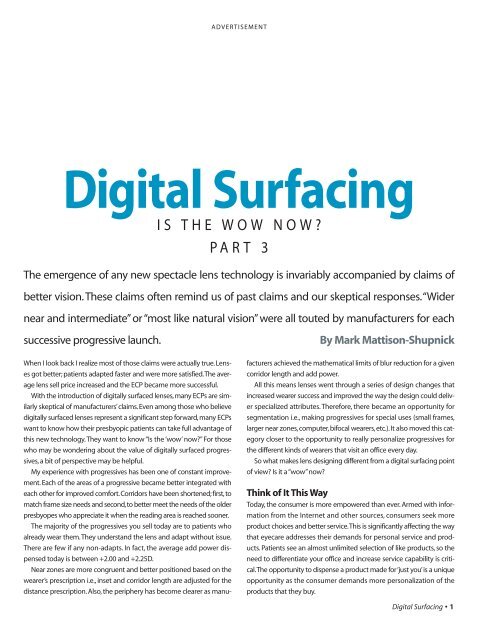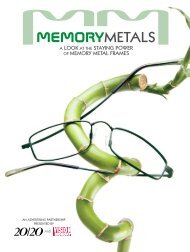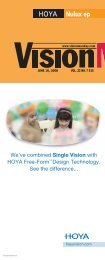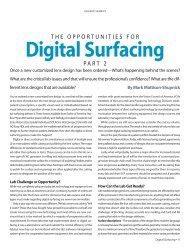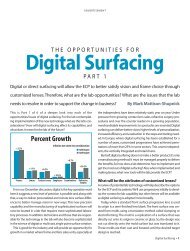The Opportunities For Digital Surfacing - Part 3
The Opportunities For Digital Surfacing - Part 3
The Opportunities For Digital Surfacing - Part 3
You also want an ePaper? Increase the reach of your titles
YUMPU automatically turns print PDFs into web optimized ePapers that Google loves.
When I look back I realize most of those claims were actually true. Lenses<br />
got better; patients adapted faster and were more satisfied.<strong>The</strong> average<br />
lens sell price increased and the ECP became more successful.<br />
With the introduction of digitally surfaced lenses, many ECPs are similarly<br />
skeptical of manufacturers’claims. Even among those who believe<br />
digitally surfaced lenses represent a significant step forward, many ECPs<br />
want to know how their presbyopic patients can take full advantage of<br />
this new technology. <strong>The</strong>y want to know “Is the ‘wow’ now?” <strong>For</strong> those<br />
who may be wondering about the value of digitally surfaced progressives,<br />
a bit of perspective may be helpful.<br />
My experience with progressives has been one of constant improvement.<br />
Each of the areas of a progressive became better integrated with<br />
each other for improved comfort. Corridors have been shortened; first, to<br />
match frame size needs and second,to better meet the needs of the older<br />
presbyopes who appreciate it when the reading area is reached sooner.<br />
<strong>The</strong> majority of the progressives you sell today are to patients who<br />
already wear them.<strong>The</strong>y understand the lens and adapt without issue.<br />
<strong>The</strong>re are few if any non-adapts. In fact, the average add power dispensed<br />
today is between +2.00 and +2.25D.<br />
Near zones are more congruent and better positioned based on the<br />
wearer’s prescription i.e., inset and corridor length are adjusted for the<br />
distance prescription. Also, the periphery has become clearer as manu-<br />
ADVERTISEMENT<br />
<strong>Digital</strong> <strong>Surfacing</strong><br />
IS THE WOW NOW?<br />
PART 3<br />
<strong>The</strong> emergence of any new spectacle lens technology is invariably accompanied by claims of<br />
better vision. <strong>The</strong>se claims often remind us of past claims and our skeptical responses.“Wider<br />
near and intermediate” or “most like natural vision” were all touted by manufacturers for each<br />
successive progressive launch. By Mark Mattison-Shupnick<br />
facturers achieved the mathematical limits of blur reduction for a given<br />
corridor length and add power.<br />
All this means lenses went through a series of design changes that<br />
increased wearer success and improved the way the design could deliver<br />
specialized attributes. <strong>The</strong>refore, there became an opportunity for<br />
segmentation i.e., making progressives for special uses (small frames,<br />
larger near zones, computer, bifocal wearers, etc.). It also moved this category<br />
closer to the opportunity to really personalize progressives for<br />
the different kinds of wearers that visit an office every day.<br />
So what makes lens designing different from a digital surfacing point<br />
of view? Is it a “wow”now?<br />
Think of It This Way<br />
Today, the consumer is more empowered than ever. Armed with information<br />
from the Internet and other sources, consumers seek more<br />
product choices and better service.This is significantly affecting the way<br />
that eyecare addresses their demands for personal service and products.<br />
Patients see an almost unlimited selection of like products, so the<br />
need to differentiate your office and increase service capability is critical.<strong>The</strong><br />
opportunity to dispense a product made for ‘just you’is a unique<br />
opportunity as the consumer demands more personalization of the<br />
products that they buy.<br />
<strong>Digital</strong> <strong>Surfacing</strong> •1
Let me quote Pierre Fay, executive vice president of Luxottica, regarding<br />
digital surfacing. He says,“In the very near future, lenses will adapt to<br />
the consumer rather than the consumer having to adapt to their lenses.”<br />
What does this mean in terms of <strong>Digital</strong> <strong>Surfacing</strong>? <strong>Digital</strong> surfacing provides<br />
the mechanism to deliver truly personalized lenses i.e.,lenses adapted<br />
for the patient’s vision and lifestyle requirements.It also meets our industry’s<br />
need for constant improvement to the way we make people see with the<br />
eyewear delivered.It increases patient satisfaction and improves business.<br />
How Will <strong>Digital</strong> <strong>Surfacing</strong> Improve Lenses?<br />
Naively, one would expect that for any variety of patients’ prescriptions,<br />
especially when they are similar, a particular progressive would deliver the<br />
same quality of vision to each patient,i.e.,the same useful performance for<br />
distance, intermediate and near with the same peripheral effects. Not so.<br />
Patients see the results of their prescriptions combined with the effects of<br />
the lens design periphery.Depending on their own needs and sensitivities,<br />
they see differences or prefer one progressive to another. <strong>Digital</strong> surfacing<br />
can reduce those differences and improve the visual experience to make<br />
more patients happier the first time.<br />
We all have experienced the<br />
patient that tells us they see differently<br />
out of the temporal side of one<br />
of their lenses. <strong>The</strong> very fact that the<br />
lower periphery of a progressive surface<br />
gets steeper faster vertically<br />
than horizontally means there will be<br />
cylinder created. When combined<br />
with the patient’s prescribed cylinder,<br />
the resulting cylinder may affect<br />
peripheral vision right or left.<br />
This effect can be illustrated using a<br />
map of RMS (root mean square) power errors. RMS is a common mathematical<br />
method of combining a number of factors into one value,here the<br />
spherical and astigmatic power errors in a progressive to create a single<br />
blur value tha can be mapped. <strong>For</strong> distance vision, the error that creates a<br />
“noticeable border”is about 0.25D, for near the value is higher. In progressives,<br />
clear functional zones usually have less than 0.5 to 0.75D of blur<br />
depending on task and sensitivity.<br />
Here, three differrent -3.00 prescriptions deliver slight differences. In<br />
these three examples, the same base curve lens ‘sees’ a little differently<br />
depending on Rx and patient perception.<br />
2• <strong>Digital</strong> <strong>Surfacing</strong><br />
RMS power error map, modern<br />
Plano distance power lens.<br />
-3.00 Sph -3.00 -1.50 x 180 -3.00 -1.50 x 45<br />
ADVERTISEMENT<br />
Here’s the same comparison for +3.00 powers.<br />
+3.00 Sph +3.00 -1.50 x 180 +3.00 -1.50 x 45<br />
<strong>The</strong> point here is to recognize that when using the same base curve for<br />
different patients,especially for those prescriptions at the edges of the prescription<br />
range, they don’t get the best vision possible.<strong>The</strong> same is true<br />
when the recommended base curve for each eye’s Rx is different. In this<br />
case, the lab will usually use the flatter base curve for both eyes in favor of<br />
cosmetics.<strong>The</strong>refore,digital surfacing can be used to fix these differences.<br />
<strong>The</strong> most flexibility to improve designs is when both surfaces can be<br />
modified through digital surfacing either where the front is created from<br />
a digitally surfaced mold and the back helps modify remaining unwanted<br />
results or when the characteristics needed for the patient will be delivered<br />
using the best combination of front and back design.<strong>The</strong>y could be<br />
a combination of progressive, toric, spherical and aspheric or atoric.<br />
<strong>For</strong> Example<br />
Let’s look at an example of a targeted design, the way it would deliver its<br />
prescription after surfacing and how a lab with digital surfacing ability<br />
could optimize that same prescription.<br />
<strong>The</strong>se following ray-traced optical astigmatism plots illustrate the point.<br />
<strong>The</strong> first illustration represents the “Intended Design for Plano +200 Add.”This<br />
is the design that we would expect for all patients using that base curve.<br />
However, when we use this lens blank for an Rx at the edge of the<br />
prescription range for that base curve, +2.00 -1.50 x 045 (with 2 deg<br />
pantoscopic tilt and a slight 5 deg face form), the distribution of astigmatism<br />
delivered is different. <strong>The</strong>re is an increase in astigmatism and<br />
the usability of the viewing zones is changed.<br />
Intended design SF Blank Surfaced<br />
to +2.00 -1.50 x 045<br />
Optimized through<br />
digital surfacing<br />
<strong>The</strong> third illustration or "Optimized Lens" file has been optimized<br />
for the Rx +2.00 -1.50 x 045 (with 2 deg of pantoscopic tilt and 5 deg<br />
of face form) and while this is actually a simulated example, the actual<br />
example is very close. Remember from <strong>Part</strong> 2 of this series, digital<br />
surfacing allows an exact surface replication of the design required. A<br />
lens can therefore be optimized to deliver better vision, and for some<br />
patients, a wow.
Design Equals Performance<br />
If digital surfacing can deliver exactly what is required to optimize vision<br />
and provide patients with a better experience for them personally, then<br />
one must start with the right design. As we said before, just being able<br />
to digitally surface lenses does not automatically mean a better lens.<br />
One must start with the right design first, one that is the result of good<br />
vision science and wearer tests that confirm their efficacy.<br />
Vertical Tasting<br />
Like wine tasting, where one can compare different brands of the same<br />
grape, one could also compare the same brand’s offerings of different<br />
years or the same year’s bottling from different vineyard blocks. <strong>The</strong>y<br />
may both be Pinot Noir from the same label but may be very different<br />
in preference.<br />
We’ve been doing the same in progressives i.e., comparing brands or<br />
new designs from preferred suppliers.Let me suggest that as professionals<br />
you compare them vertically. Compare your previous best PAL with<br />
the ‘new digitally surfaced’ design. So consider a personal comparison of<br />
Varilux Comfort with Varilux Physio and Varilux Physio 360° or SOLA Percepta,<br />
SOLAOne and SOLAOne HD. Where there are small and subtle<br />
changes noticed initially,when you go back to the previous version after a<br />
ADVERTISEMENT<br />
period of time,it’s easy to see where the improvements have been made.<br />
Try it with Varilux Ellipse and new Varilux Ellipse 360° or AO Compact,<br />
AO Compact Ultra and AO Compact Ultra HD.<br />
What are the new attributes that<br />
can be changed or improved?<br />
Improvements to the way that a lens delivers its intended design, also<br />
means that aberrations and environment have less of an effect on the<br />
vision of the patient. A reduction of aberrations like coma, or an<br />
improvement to the contrast of objects improves the way patients see.<br />
Coma, a comet-shaped blur that causes images to flare, affects offcenter<br />
acuity and further blurs the edges of the object, reducing contrast.<br />
Reducing coma improves the visual experience, particularly in low<br />
light conditions.This improvement can be seen especially around lights<br />
at night since the pupil is larger. As a result, vision is clearer because<br />
there is less aberration and an improvement in contrast. More about<br />
contrast sensitivity in <strong>Part</strong> 5.<br />
To further improve vision in the mid-range band, the orientation and<br />
effect of the front surface astigmatism is reduced by digitally surfacing<br />
the back so the border of the corridor is widened. If more vertical, vision<br />
is clearer and the usable field of view is increased.<br />
My View<br />
Michael Morris, OD, Carl Zeiss Vision Inc., Senior Director, Americas, Professional Relations and Clinical Affairs<br />
My View of Customized Progressives<br />
I have been doing progressive lens research and development for<br />
more than 15 years, and the most exciting thing to come along in that<br />
time is direct surfacing production technology.This enabling technology<br />
can liberate us from the constraints that have hobbled us since<br />
the invention of progressives—but only if we use it wisely.<br />
Direct surfacing production offers a number of significant<br />
advantages over the semi-finished manufacturing model.<br />
<strong>The</strong> first is freedom from the limitations of semi-finished progressive<br />
lens blanks, which force us to cover the full range of<br />
prescribed powers with a limited number of base curves.<br />
With these, people whose prescriptions are near the boundary<br />
between two recommended base curves do not get the<br />
same quality of vision as those lucky people whose prescriptions<br />
are at the center of the range. With the right software<br />
and freeform production, we can optimize each lens for each<br />
individual prescription.<br />
Another advantage is that a wide range of products can be made<br />
from a relatively small number of lens blanks. This simplifies production<br />
systems and allows more flexibility to offer a wider range of<br />
designs with more material options.<br />
But the biggest advantage, by far, is that we now have the potential<br />
to deliver customized progressive lenses based on individual patient<br />
needs.With conventional progressive lenses, everyone is forced to wear<br />
a design chosen from a very limited range of choices. I like to compare<br />
customized progressives to tailored suits: each person chooses a style<br />
that fits his or her needs, and then that suit is individually fit for the best<br />
comfort, performance and appearance. By comparison, what we cur-<br />
rently do for patients is lead them all to the same rack of clothes with<br />
a very limited range of styles and sizes.<br />
A progressive lens must deliver all ranges of vision in a very limited<br />
space. Right now, you don’t get to choose how much of the lens<br />
should be allocated for distance, how much for near, or how much for<br />
distances in between. Of course, you could try to match patients to the<br />
semi-finished lenses that are closest to their needs, but that would<br />
require an encyclopedic knowledge of existing designs, as well as<br />
extra dispensing time.<br />
Wouldn’t it be ideal if every patient could get the right balance of<br />
lens properties that fit the kinds of activities they do each day? <strong>The</strong><br />
retail clerk who stands all day needs a reading area located lower in<br />
the lens than the retiree who reads books in a recliner. A taxi driver<br />
who likes to go to ballgames may need more distance vision than the<br />
engineer who spends a lot of time with his Xbox. I believe direct surface<br />
manufacturing is the enabling technology that makes it practical<br />
to deliver truly customized progressive lenses.<br />
I also have some concerns. I worry that products that don’t offer<br />
clear advantages over semi-finished progressives are damaging the<br />
reputation of this wonderful technology. I fear that the industry is creating<br />
confusion by making exaggerated claims. I know we risk alienating<br />
eyecare professionals by adding complexity to the lens selection<br />
and dispensing process. And I am not sure all laboratories are set up<br />
to verify the very complex optical surfaces created by this form of<br />
manufacturing.<br />
Despite these concerns, I am certain we have entered a new era<br />
and that customized progressives will provide better vision for all of<br />
our patients and greater success for eyecare professionals.<br />
<strong>Digital</strong> <strong>Surfacing</strong> •3
Flare around Crisper image<br />
Surface astigmatism is reduced and made more vertical for a wider clear field of vision<br />
What about single-vision and other<br />
multifocal lenses?<br />
Better vision and a better visual experience are not limited to the progressive<br />
wearer.Think personalized for single vision. In this instance look<br />
around the store and find those frames that have created the most<br />
vision issues when trying to add the patient’s prescription.<br />
<strong>Digital</strong> surfacing will improve the way that we deliver wrap eyewear<br />
prescriptions by being able to modify the lens periphery as well<br />
as the on center prescription effects. At some point, the very personal<br />
choice of frame won’t inhibit the way that its lenses deliver vision.<br />
<strong>For</strong> traditional multifocals, the choices will be similar. <strong>For</strong> those that<br />
will not buy progressives, the opportunity to improve the total vision<br />
experience by adding an asphere or atoric as the back lens surface can<br />
improve the clear field of view.<br />
Is there a perfect patient?<br />
Since lens maps and design have never been absolute predictors in<br />
patient preference, can one pick the perfect patient for digitally surfaced<br />
designs?<br />
Improved clarity and reduced distortion are advantages for all<br />
patients.Some patients less sensitive to the effects of lenses or with moderate<br />
prescriptions may not notice large differences. If the benefits cannot<br />
be demonstrated then the increased costs may be difficult to justify.<br />
However, most patients will see incrementally better, near<br />
emmetropes (low power prescriptions) and high power or high cylinder<br />
(>1.50D cyl) should be immediately impressed with their new eyewear.<br />
<strong>The</strong> patient that wants the best in the category is also ideal for these<br />
lenses. <strong>The</strong> practice that positions itself on delivering the best in care<br />
ADVERTISEMENT<br />
Sponsored by<br />
and the products they dispense is also the right practice to convert the<br />
majority of their patients to digitally surfaced lenses.<br />
Lastly, the patients that have adapted but still are somewhat dissatisfied<br />
with the performance of their current progressives are an important<br />
segment of the target patient base.<strong>The</strong>y like and wear progressives<br />
but want a larger clear field of view or crisper vision. <strong>Digital</strong>ly surfaced<br />
lenses can make the difference.<br />
Should the ECP write Rx’s in a different way?<br />
No. <strong>Digital</strong> surfacing builds the sophistication into the lens. <strong>The</strong>re may<br />
be some additional information required.<br />
Most progressives make an assumption of fitting vertex; frame tilt<br />
and face form so with careful monocular PD and fitting height measurements<br />
lenses deliver the intended benefits.<br />
Some new digitally surfaced lenses will require vertex and tilt values<br />
to better personalize the Rx. We’ll review this in more detail when we<br />
discuss the precision opportunities for new measuring devices. <strong>For</strong><br />
more information, refer to the Essilor or Zeiss lens requirements.<br />
New since last article<br />
Introduced for the first time at the MIDO<br />
trade show in Milan, Italy, Schneider<br />
Optical Machinery premiered a complete<br />
on-board laser-marking unit in its<br />
digital surfacing generator HSC smart.<br />
<strong>The</strong> integration of the laser marking into<br />
the generator enables perfectly positioned<br />
markings and significant cost sav-<br />
Integrated laser marking<br />
ings for small to mid-sized labs implementing digital surfacing.<br />
Varilux Ellipse is now available in a Varilux Ellipse 360° version.<strong>The</strong> short<br />
corridor front surface design is further personalized using Point-By-Point<br />
Prescription Mapping.<strong>The</strong> result is a unique back-side design that optimizes<br />
each Varilux Ellipse progressive prescription to maximize the patient’s field<br />
of vision and reduce lens distortion. Since 85 percent of add power is<br />
achieved in 9.5mm,minimum fitting heights of 13mm are possible.<br />
Carl Zeiss Vision has extended its offering of direct-surface customized<br />
lenses by adding SOLA Compact ULTRA HD in 1.67 clear and<br />
Transitions Gray. An advanced short-corridor progressive lens design,<br />
Compact ULTRA features a low 13mm minimum fitting height that<br />
allows progressive wearers to select from a wider variety of smaller, fashionable<br />
frames. This fitting height is made possible by a revolutionary<br />
corridor design that delivers unsurpassed reading area at all fitting<br />
heights. <strong>The</strong> Compact ULTRA design also offers excellent binocularity,<br />
low skew distortion and low astigmatism.


